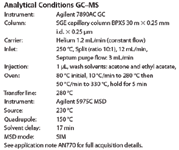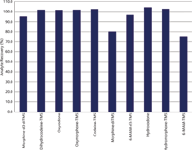Extraction of a Range of Opiates and Metabolites From Urine Using ISOLUTE SLE+ with GC–MS Analysis
Biotage AB Application Note
This application note demonstrates an effective and efficient supported liquid extraction protocol for the clean-up and concentration of a range of forensically significant opiates and their metabolites from urine prior to analysis by GC–MS. ISOLUTE SLE+ Supported Liquid Extraction columns offer an efficient alternative to traditional liquid-liquid extraction (LLE) for bioanalytical sample preparation, providing high analyte recoveries, no emulsion formation and significantly reduced sample preparation time.
Extraction Conditions
Sample pre-treatment: Dilute urine (1 mL) with 100 mM ammonium acetate pH 5 (950 µL) and β-Glucuronidase enzyme (50 µL). Hydrolyze in a water bath at 60 °C for 2 h. Cool and add 25% ammonium hydroxide in water (10 µL) and vortex.
Sample loading: Load the pre-treated sample (1 mL) onto the ISOLUTE SLE+ 1 mL Sample Volume column (820-0140-C) and apply positive pressure (PRESSURE+ 48 Positive Pressure Manifold PPM–48) to initiate flow. Allow the sample to adsorb for 5 min.
Analyte extraction: Apply dichloromethane:isopropanol (95:5, v/v) (2.5 mL) and allow to flow under gravity for 5 min. Apply a second aliquot of dichloromethane:isopropanol (95:5, v/v) (2.5 mL) and allow to flow for another 5 min. Apply positive pressure to elute any remaining extraction solvent.
Post-extraction: Evaporate the extract to dryness (40 ºC). Reconstitute in ethyl acetate (500 µL) and transfer to high recovery glass vial. Evaporate the extract to dryness (40 ºC). Derivatize with BSTFA:TMCS (99:1, v/v) (20 µL) and dichloromethane/isopropanol (95:5, v/v) (20 µL). Seal with non-split caps and heat in a heating block at 70 ºC for 30 min.

Results
This ISOLUTE SLE+ protocol demonstrates analyte recoveries ranges from 70–99% as shown in Figure 1. Relative standard deviations (RSDs) were below 5% for all analytes. Robustness testing was carried out across three days using three different sources of urine, showing comparable recoveries and limits of quantitation ranging from 2–200 ng/mL, analyte dependent.

Figure 1: Typical analyte % recoveries for a range of extracted opiates (n = 7) using the ISOLUTE SLE+ protocol.
Conclusions
This method demonstrates a quick and effective alternative to the solid phase extraction of opiates from urine. The supported liquid extraction protocol not only produced robust and reproducible recoveries, but also reached the lower limits of quantitation required for each analyte.
Biotage AB
Vimpelgatan 5, Uppsala, Sweden
tel. +46 18 56 59 00 fax +46 18 59 19 22
Email: info@biotage.com
Website: www.biotage.com


.png&w=3840&q=75)

.png&w=3840&q=75)



.png&w=3840&q=75)



.png&w=3840&q=75)








